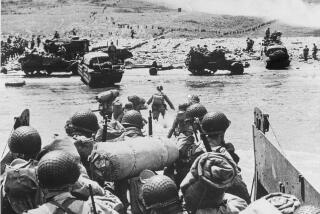Project Seeks Accurate D-Day Tally
- Share via
BEDFORD, Va. — The National D-Day Memorial Foundation is working on an accounting of U.S. and Allied forces who died in the June 6, 1944, Normandy invasion that broke Adolf Hitler’s grasp on Europe.
“There really is no accurate list of everyone who was killed,” foundation President William McIntosh said. “The estimates people have cited spike as high as 12,000 and go as low as 5,500. When you have that kind of disparity, you know that more work needs to be done.”
The foundation plans to display the names on bronze plaques at the tribute next Memorial Day. They won’t be named alphabetically, because the list would take much longer to compile.
Foundation researcher Carol Tuckwiller said her work has confirmed about 3,700 fatalities and expects the number to reach 4,500. Using national archives and various military databases, she also is working through 1,000 names of military personnel listed as missing in action after D-day.
“Many of these are later turning up back on duty, or they showed up in hospitals in England, or later reports say they died of wounds in other battles,” she said.
Trying to track the more than 130,000 Allied troops who spread across 50 miles of French coastline is as difficult today as it was the day of the invasion, Tuckwiller said.
“There was so much confusion that day,” she said. “The field reports kept changing. Months later, they were still determining the people that died there.”
Mitchell Yockelson, a reference archivist at the National Archives Modern Military Records Branch in College Park, Md., marvels at the amount of work Tuckwiller has done.
“It’s an enormous task,” Yockelson said. “There’s not one consolidated source of records. You’re dealing with different agencies of the War Department, and everybody records things differently.”
Daily reports, stored in the National Personnel Records Center in St. Louis, were filled out by commanders and keep track of casualties.
The microfilmed records are sorted by date, so Tuckwiller had to sift through troop movements in Guam, domestic training reports and everything else the U.S. military was doing that day.
Unit reports and histories are filed after the war and usually don’t provide the dates of those killed in action.
Besides counting names, Tuckwiller has gleaned insight into the invasion from the dusty paper documents.
“In some reports, the commanders said morale was low because the men didn’t receive the mail that day,” she said. “They were always trying to get families to write every day, and now you see why.”
More to Read
Sign up for Essential California
The most important California stories and recommendations in your inbox every morning.
You may occasionally receive promotional content from the Los Angeles Times.













